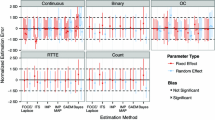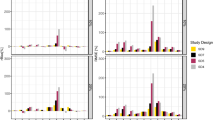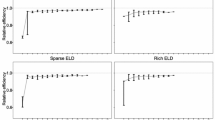Abstract
Optimization of the sampling schedule can be used in pharmacokinetic (PK) experiments to increase the accuracy and the precision of parameter estimation or to reduce the number of samples required. Several optimization criteria that formally incorporate prior parameter uncertainty have been proposed earlier. These criteria consist in finding the sampling schedule that maximizes the expectation (over a given parameter distribution) of det F (ED-optimality) or Log(det F) (API-optimality), or minimizes the expectation of 1/det F (EID-optimality), where F is the Fisher information matrix. The precision and the accuracy of parameter estimation after having fitted a PK model to a small number of optimal data points (determined according to D, ED, EID, and API criteria) or to a naive sampling schedule were compared in a Monte Carlo simulation study. A one-compartment model with first-order absorption rate (3 parameters) and a two-compartment model with zero-order infusion rate (4 parameters) were considered. Data were simulated for 300 subjects with both structural models, combined with several residual error models (homoscedastic, heteroscedastic with constant or variable coefficient of variation). Interindividual variabilities in PK parameters ranged from 25–66%. ED-, EID-, and API-optimal sampling times were calculated using the software OSP-Fit. Three or five samples were allowed for parameter estimation by extended least-squares. Performances of each design criterion were evaluated in terms of mean prediction error, root mean squared error, and number of acceptable estimates (i.e., with a SE less than 30%). Compared to the D-optimal design, the EID and API designs reduced the bias and the imprecision of the estimation of the parameters having a large interindividual variability. Moreover, the API design resulted in some cases in a higher number of acceptable estimates.
Similar content being viewed by others
REFERENCES
E. R. Corson, C. Cobelli, and L. Finkelstein. The Mathematical Modelling of Biological and Endocrine Systems, Wiley-Interscience, New York, 1983.
E. M. Landaw. Optimal design for individual parameter estimation in pharmacokinetics. In Variability in Drug Therapy: Description, Estimation and Control, Raven Press, New York, 1985, pp. 187–200.
D. Z. D'Argenio. Optimal sampling times for pharmacokinetic experiments. J. Pharmacokin. Biopharm. 9:739–756 (1981).
G. L. Drusano, A. Forrest, M. J. Snyder, M. D. Reed, and J. L. Blumer. An evaluation of optimal sampling strategy and adaptive study design. Clin. Pharmacol. Ther. 44:232–238 (1988).
G. L. Drusano, A. Forrest, K. I. Plaisance, and J. C. Wade. A prospective evaluation of OST in the determination of the steady-state pharmacokinetics of piperacillin in febrile neutropenic cancer patients. Clin. Pharmacol. Ther. 45:635–641 (1989).
G. L. Drusano. OST and population modelling: application to determination of the influence of microgravity environment on drug distribution and elimination. J. Clin. Pharmacol. 31:962–967 (1991).
L. Pronzato and E. Walter. Robust experiment design via maximin optimization. Math. Biosci. 89:161–176 (1988).
L. Pronzato and E. Walter. Robust experiment design via stochastic approximation. Math. Biosci. 75:103–120 (1985).
E. Walter and L. Pronzato. Optimal experiment design for nonlinear models subject to large prior uncertainties. Am. J. Physiol. 253:R530–R534 (1987).
D. Z. D'Argenio. Incorporating prior parameter uncertainty in the design of sampling schedules for pharmacokinetic parameter estimation experiments. Math. Biosci. 99:105–118 (1990).
L. Pronzato, C. Y. Huang, E. Walter, Y. Le Roux, and A. Frydman. Planification d'experiences pour l'estimation de paramètres pharmacocinétiques. In Informatique et Santé 2, Springer-Verlag, 1989, pp. 3–13.
M. Tod and J. M. Rocchisani. Implementation of OSPOP, an algorithm for the estimation of optimal sampling times in pharmacokinetics by the ED, EID and API criteria. Comput. Meth. Prog. Biomed. 50:13–22 (1996).
Y. Merlé. Planification de protocoles bayésiens expérimentaux pour l'estimation des paramètres individuels d'un modèle. Ph.D Thesis, Université Paris VII 1996, pp. 1–173.
M. Tod and R. Gomeni. OSP-Fit User's Manual, Bestfit S.A., L-2210 Luxembourg, 1996.
D. Z. D'Argenio and A. Schumitzky. ADAPT II User's Guide, Biomedical Simulation Resource, University of Southern California. Los Angeles, 1992.
L. B. Sheiner and S. Beal. Some suggestions for measuring predictive performance. J. Pharmacokin. Biopharm. 9:503–512 (1981).
A. Pazman. Small-sample distributional properties of non-linear regression estimators (a geometric approach) (with discussion). Statistics 21:323–367 (1990).
M. Tod, C. Padoin, K. Louchahi, B. Moreau-Tod, O. Petitjean, and G. Perret. Application of OST to the determination of metacycline pharmacokinetic parameters: effect of model misspecification. J. Pharmacokin. Biopharm. 22:129–146 (1994).
T. M. Ludden, S. L. Beal, and L. B. Sheiner. Comparison of the Akaike information criterion, the Schwarz criterion and the F test as guides to model selection. J. Pharmacokin. Biopharm. 22:431–445 (1994).
Y. Merlé, F. Mentré, A. Mallet, and A. H. Aurengo. Designing an optimal experiment for bayesian estimation: application to the kinetics of iodine thyroid uptake. Stat. Med. 13:185–196 (1994).
F. Mentré, P. Burtin, Y. Merlé, J. Van Bree, A. Mallet, and J. L. Steimer. Sparse-sampling optimal designs in pharmacokinetics and toxicokinetics. Drug Inform. J. 29:997–1019 (1995).
Y. Merlé and F. Mentré. Bayesian design criteria: computation, comparison, and application to a pharmacokinetic and a pharmacodynamic model. J. Pharmacokin. Biopharm. 23:101–125 (1995).
Author information
Authors and Affiliations
Rights and permissions
About this article
Cite this article
Tod, M., Rocchisani, JM. Comparison of ED, EID, and API Criteria for the Robust Optimization of Sampling Times in Pharmacokinetics. J Pharmacokinet Pharmacodyn 25, 515–537 (1997). https://doi.org/10.1023/A:1025701327672
Published:
Issue Date:
DOI: https://doi.org/10.1023/A:1025701327672




